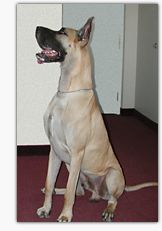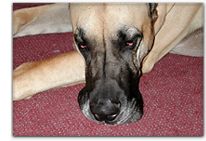|
– Gone
in a Phlash –
June 24,
2002 – This week's DaDane
is dedicated to all the Great Danes who've been lost to a serious
form of heart disease known as Dilated Cardiomyopathy (DCM) –
and to the broken hearts they've left behind. Pictured above is
Nan English's Phlash who passed away
on May 4, 2002, after a long struggle with DCM. This is the story
of Phlash's final months, in the words of the person who loved him
most.
ONE
LAST JOURNEY
By
Nan English

 "Danes
are a heartbreak breed, you know?" My vet has said
that to me many a time. As with most people who have Danes,
I know the meaning of this statement all too well. You see,
I was the second child. The first child in our family
was a Great Dane. It has been such in my family all of these
many years. "Danes
are a heartbreak breed, you know?" My vet has said
that to me many a time. As with most people who have Danes,
I know the meaning of this statement all too well. You see,
I was the second child. The first child in our family
was a Great Dane. It has been such in my family all of these
many years.

My heart has been broken again. I lost my dear friend, Phlash,
to a dastardly disease: Dilated
Cardiomyopathy (DCM). This disease is devastating
to dog, owner, family and friends.

I would like to tell you all about my very, very special
Dane named Phlash. But instead I will write about our last
journey together. My hope is that our story can help the
Dane community in its fight against DCM – and help
others like me and Phlash who find themselves faced with
this horrendous terminal disease.
|
What
is DCM?

Dilated cardiomyopathy is a primary
heart muscle disease usually characterized by
enlargement of the left ventricle. The muscle
wall of the ventricle becomes thin and stretches,
resulting in an enlargement and weakening of
the chamber. The weakened heart muscle can no
longer pump blood effectively. This causes a
buildup of fluid in the lungs and elsewhere.
It eventually leads to heart failure.
|
|
In
the beginning, it was just a cough

Our story began in the wee hours of a Saturday morning in
late January, 2002. I woke up to hear Phlash coughing. It
sounded like he had a hair or something caught in his throat
and he couldn't clear it. When the coughing ended, I thought,"Good!"
But it had been a troubling sound, so later I emailed several
people I knew to be knowledgeable about the breed, one of
whom is a vet who owns large dogs. The responses were about
what I expected... not to worry. One response, however,
had an addendum which caused me concern. In addition to
some other comments, my friend said that the only other
time she observed such a cough had been with a DCM dog.

The next week rolled around and all was well. No coughing.
All normal. Five nights later things changed. Again there
was coughing. The next day, Phlash and I headed to the vet.
A series of tests were run and the results forwarded to
a canine cardiac specialty clinic for evaluation. After
some waiting, my veterinarian came out of his office. I
knew from the look on his face that it was not good. I listened
to the bad news but I was in a fog. All the time I was stroking
Phlash. Here stood what appeared to be a healthy and strong
Dane. He was highly muscled from all the running that he
did daily. His weight was great. He had never had a sick
day. But looks can deceive. I was informed that Phlash's
heart was in very bad shape. It was Black Friday for us...
and that was an understatement!
|
Basic
Medication

The base medications that are usually prescribed
for DCM are diuretics, digoxin, and ACE inhibitors.
Diuretics are given to relieve the fluid buildup
in the body. Since
the diuretics tend to leach potassium, potassium
supplements may be necessary. Digoxin
(or other digitalis medicines) is given to help
the heart beat stronger and to control some
types of abnormal heart beats. ACE (angiotensin
converting enzymes) inhibitors
improve cardiac output. They widen the blood
vessels and lower blood pressure.
|
|
Living
with DCM

The next day, we began a new daily ritual: pills, pills, and
more pills. Morning and night, it was pills. Phlash was taking
Lasix, Digoxin, and Lotensin. The first week was no problem.
While Phlash was a bit "off," he was eating, swallowing
his pills, coming for loving and, as always, checking the
fence line.

The
second week, Phlash lost his appetite. Little enticed him.
Understand, this boy was an "easy keeper." He was
never a picky eater. This was the beginning of an enormous
weight loss. I began racking my brain for all the things I
had heard about getting picky eaters to eat. What I was not
"getting" was that this was not a case of
Phlash being picky. Nothing tasted good to him and he had
virtually no appetite. Hamburger would taste okay for a couple
of days – and then he would refuse it. The same
was true of other things that we tried: cheese, ice cream,
etc. It was at the end of Week 2 when I began giving him Coenzyme
Q-10, an enzyme that is found naturally in the cells of the
heart walls. (Age and illness can suppress the generation
of sufficient quantities of CoQ-10. Giving CoQ-10 can help
to strengthen the heart cells and lower blood pressure.)

The third week was probably the worst. I was quite concerned
about the small amount of food that Phlash was eating and
the weight he was losing. At this point he was not always
steady on his feet. I knew that I needed to get some proteins
into him – and fast. At the end of the week we discovered
the wonders of cat food. This seemed to be the one thing that
always tasted good to Phlash. His eyes would dance when he
saw me grab the can opener. I cannot remember a time when
he turned down a bit of cat food.

 By
the fifth week, Phlash began to eat a fairly consistent amount
of food each day. It would vary from just under 4 cups of
kibble a day to a bit over 6 cups. In addition, he would get
hamburger, tuna, cat food, etc. I also added a food supplement
given to young lambs that need sustenance to survive. It gave
Phlash good protein and calories without a bunch of fat for
his body to process. Still, the weight kept dropping off.
Later I learned that DCM is a "wasting" disease.
Phlash's body was needing more protein and it was using that
which was in his muscles. By
the fifth week, Phlash began to eat a fairly consistent amount
of food each day. It would vary from just under 4 cups of
kibble a day to a bit over 6 cups. In addition, he would get
hamburger, tuna, cat food, etc. I also added a food supplement
given to young lambs that need sustenance to survive. It gave
Phlash good protein and calories without a bunch of fat for
his body to process. Still, the weight kept dropping off.
Later I learned that DCM is a "wasting" disease.
Phlash's body was needing more protein and it was using that
which was in his muscles.

Mid-March came, and along with that, Phlash's 5th birthday.
Wow! A few weeks earlier, I doubted that we would find ourselves
celebrating. Well, let me tell you, the boy's feet and eyes
danced when he saw what he was getting. Thanks to our dear
friend Dorris, Phlash enjoyed filet mignon and ice cream.
What a happy day!

The next few weeks continued about the same. Phlash was eating
again. And while he rarely did more than a trot, he still
did the ritual fence check. Only occasionally now did he roll
in the grass on his back. By this time, his belly was full
of fluid and he could no longer lay on his side. The burden
of the extra fluid was making his heart work even harder.
Little by little, things were becoming more difficult. Sleeping
was not easy until I thought of body pillows. You see, when
Phlash relaxed, he would fall over on his side and that would
wake him. The body pillows kept him upright. He slept well
after that. Despite his increasing problems, one thing about
Phlash did not change – his demeanor. No matter
how bad he felt, Phlash was still the boy who loved people
and felt the joy of life.

Letting go

 On
a crisp morning in early May, Phlash and I enjoyed a picnic
breakfast of bacon, egg and cheese biscuits. My boy was full
of joy. He was so, so happy to greet his friends and he enjoyed
conning just one more bite. I will never forget that look
of pure happiness. I gazed at Phlash and saw my handsome boy
– not the wasted skeleton in front of me. (Earlier I
had told Phlash that we couldn't let anyone who didn't know
us see him. They would think I'd starved him. He was so very
thin, you could see every bone.) I am convinced that Phlash's
joy of life is the only thing that kept him by my side towards
the end. But I knew that it was time to let him go. Later
that morning, I held Phlash and told him how much he meant
to me and how much I loved him. Then he was gone. On
a crisp morning in early May, Phlash and I enjoyed a picnic
breakfast of bacon, egg and cheese biscuits. My boy was full
of joy. He was so, so happy to greet his friends and he enjoyed
conning just one more bite. I will never forget that look
of pure happiness. I gazed at Phlash and saw my handsome boy
– not the wasted skeleton in front of me. (Earlier I
had told Phlash that we couldn't let anyone who didn't know
us see him. They would think I'd starved him. He was so very
thin, you could see every bone.) I am convinced that Phlash's
joy of life is the only thing that kept him by my side towards
the end. But I knew that it was time to let him go. Later
that morning, I held Phlash and told him how much he meant
to me and how much I loved him. Then he was gone.

One journey
ends, another begins...

Thus ended one phase of our journey. The journey is not over.
There is work to do. We need to learn more about DCM, how
it is passed, its marker. We need to support those owners
and dogs who find themselves facing DCM. (I know that I could
not have made it without the help and support from those who
had passed the same way before me, and my Dane friends.) Breeders
must learn more about this devastating disease. We cannot
hide from it. We can beat this by supporting research, learning
what must be done if we find a DCM dog in our offspring, and
being open and honest. We can – and MUST – win this
battle.

Please
note, this is but a brief diary look into our experiences
and emotions as we faced DCM. It is only a small peek at our
life after the onset of DCM and how we muddled through. It
is not meant to have any function other than to tell our story
and encourage people to learn more and help in the fight against
Dilated Cardiomyopathy.
 –
Nan English –
Nan English
|
Next week we'll take a deeper look at dilated
cardiomyopathy and some compelling research that's currently underway
to understand how this disease may be transmitted in Great Danes.
>>
Next installment >>
©2002-2008
by Ginnie Saunders. All rights are reserved. No part of this web
site
may be reproduced or transmitted in any form or by any means —
electronic or mechanical, including photocopying, recording, or by
any information storage or retrieval system — without written
permission from Ginnie
Saunders. To learn more about copyright issues on the web,
visit the Web Law
FAQ.
Ginnie.com, Inc.
PO Box 50314
Columbia, SC 29250
(803) 783-3169
www.ginnie.com
|


|

![]()



 "Danes
are a heartbreak breed, you know?" My vet has said
that to me many a time. As with most people who have Danes,
I know the meaning of this statement all too well. You see,
I was the second child. The first child in our family
was a Great Dane. It has been such in my family all of these
many years
"Danes
are a heartbreak breed, you know?" My vet has said
that to me many a time. As with most people who have Danes,
I know the meaning of this statement all too well. You see,
I was the second child. The first child in our family
was a Great Dane. It has been such in my family all of these
many years By
the fifth week, Phlash began to eat a fairly consistent amount
of food each day. It would vary from just under 4 cups of
kibble a day to a bit over 6 cups. In addition, he would get
hamburger, tuna, cat food, etc. I also added a food supplement
given to young lambs that need sustenance to survive. It gave
Phlash good protein and calories without a bunch of fat for
his body to process. Still, the weight kept dropping off.
Later I learned that DCM is a "wasting" disease.
Phlash's body was needing more protein and it was using that
which was in his muscles.
By
the fifth week, Phlash began to eat a fairly consistent amount
of food each day. It would vary from just under 4 cups of
kibble a day to a bit over 6 cups. In addition, he would get
hamburger, tuna, cat food, etc. I also added a food supplement
given to young lambs that need sustenance to survive. It gave
Phlash good protein and calories without a bunch of fat for
his body to process. Still, the weight kept dropping off.
Later I learned that DCM is a "wasting" disease.
Phlash's body was needing more protein and it was using that
which was in his muscles. On
a crisp morning in early May, Phlash and I enjoyed a picnic
breakfast of bacon, egg and cheese biscuits. My boy was full
of joy. He was so, so happy to greet his friends and he enjoyed
conning just one more bite. I will never forget that look
of pure happiness. I gazed at Phlash and saw my handsome boy
– not the wasted skeleton in front of me. (Earlier I
had told Phlash that we couldn't let anyone who didn't know
us see him. They would think I'd starved him. He was so very
thin, you could see every bone.) I am convinced that Phlash's
joy of life is the only thing that kept him by my side towards
the end. But I knew that it was time to let him go. Later
that morning, I held Phlash and told him how much he meant
to me and how much I loved him. Then he was gone.
On
a crisp morning in early May, Phlash and I enjoyed a picnic
breakfast of bacon, egg and cheese biscuits. My boy was full
of joy. He was so, so happy to greet his friends and he enjoyed
conning just one more bite. I will never forget that look
of pure happiness. I gazed at Phlash and saw my handsome boy
– not the wasted skeleton in front of me. (Earlier I
had told Phlash that we couldn't let anyone who didn't know
us see him. They would think I'd starved him. He was so very
thin, you could see every bone.) I am convinced that Phlash's
joy of life is the only thing that kept him by my side towards
the end. But I knew that it was time to let him go. Later
that morning, I held Phlash and told him how much he meant
to me and how much I loved him. Then he was gone. 